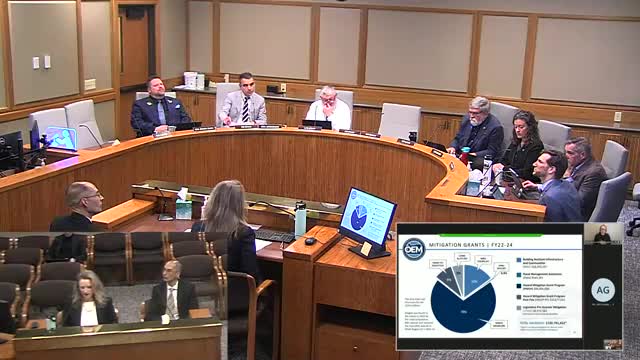Oregon secures $120.8M in disaster mitigation funding to enhance community resilience
April 07, 2025 | Public Safety, Ways and Means, Joint, Committees, Legislative, Oregon
This article was created by AI summarizing key points discussed. AI makes mistakes, so for full details and context, please refer to the video of the full meeting. Please report any errors so we can fix them. Report an error »

The Joint Committee on Ways and Means Subcommittee on Public Safety convened on April 7, 2025, to discuss critical funding and operational strategies aimed at enhancing Oregon's disaster resilience and emergency response capabilities. The meeting highlighted significant federal funding secured by the state, totaling approximately $120.8 million for fiscal years 2022 through 2024, aimed at bolstering community resilience against disasters.
Key discussions centered around various funding programs, including the Building Resilient Infrastructure and Communities (BRIC) program, which received $18 million, and the Hazard Mitigation Grant Program (HMGP), which was allocated $84.9 million. Additional funds were designated for flood management assistance and post-fire hazard mitigation, totaling over $10 million. However, the meeting underscored the challenges local governments face in meeting cost-share requirements, which have been identified as a primary barrier to accessing these federal funds.
The committee noted that House Bill 5006, passed in 2021, provided a one-time allocation of $20 million to assist local governments with cost-sharing for the Hazard Mitigation Grant Program, particularly in the wake of the 2020 wildfires. Despite these efforts, small rural communities continue to struggle with the 25% cost-share requirement, which remains a significant obstacle for jurisdictions applying for Federal Emergency Management Agency (FEMA) funding.
Oregon has led FEMA Region 10 in securing competitive grants, thanks to the dedicated efforts of state staff providing technical assistance at the local level. The committee expressed hope that federal partners would continue to support mitigation programs, especially as the BRIC grant program faces uncertainties.
The meeting also addressed the need for enhanced staffing within the Oregon Emergency Management (OEM) to maintain an "enhanced status" with FEMA, which would allow for increased funding and improved grant administration. A policy option package was proposed to permanently reclassify two key mitigation positions to support this goal.
In terms of disaster recovery, the OEM reported that Oregon managed over 2,800 projects across ten open disaster declarations, with reimbursements totaling $1.3 billion in disaster recovery costs last year. The state has experienced a significant increase in disaster declarations and recovery costs, necessitating a well-trained program staff to coordinate recovery efforts effectively.
The meeting concluded with a discussion on the transfer of the Statewide Interoperability Coordination (SWIC) program to OEM, aimed at improving communication among emergency responders during disasters. This integration is expected to enhance the state's ability to respond to emergencies effectively, ensuring that communication remains intact even in the face of significant disruptions.
Overall, the meeting underscored Oregon's proactive approach to disaster mitigation and recovery, while also highlighting the ongoing challenges faced by local governments in accessing necessary funding and resources. The committee's discussions will inform future actions and strategies to enhance the state's resilience against disasters.
Key discussions centered around various funding programs, including the Building Resilient Infrastructure and Communities (BRIC) program, which received $18 million, and the Hazard Mitigation Grant Program (HMGP), which was allocated $84.9 million. Additional funds were designated for flood management assistance and post-fire hazard mitigation, totaling over $10 million. However, the meeting underscored the challenges local governments face in meeting cost-share requirements, which have been identified as a primary barrier to accessing these federal funds.
The committee noted that House Bill 5006, passed in 2021, provided a one-time allocation of $20 million to assist local governments with cost-sharing for the Hazard Mitigation Grant Program, particularly in the wake of the 2020 wildfires. Despite these efforts, small rural communities continue to struggle with the 25% cost-share requirement, which remains a significant obstacle for jurisdictions applying for Federal Emergency Management Agency (FEMA) funding.
Oregon has led FEMA Region 10 in securing competitive grants, thanks to the dedicated efforts of state staff providing technical assistance at the local level. The committee expressed hope that federal partners would continue to support mitigation programs, especially as the BRIC grant program faces uncertainties.
The meeting also addressed the need for enhanced staffing within the Oregon Emergency Management (OEM) to maintain an "enhanced status" with FEMA, which would allow for increased funding and improved grant administration. A policy option package was proposed to permanently reclassify two key mitigation positions to support this goal.
In terms of disaster recovery, the OEM reported that Oregon managed over 2,800 projects across ten open disaster declarations, with reimbursements totaling $1.3 billion in disaster recovery costs last year. The state has experienced a significant increase in disaster declarations and recovery costs, necessitating a well-trained program staff to coordinate recovery efforts effectively.
The meeting concluded with a discussion on the transfer of the Statewide Interoperability Coordination (SWIC) program to OEM, aimed at improving communication among emergency responders during disasters. This integration is expected to enhance the state's ability to respond to emergencies effectively, ensuring that communication remains intact even in the face of significant disruptions.
Overall, the meeting underscored Oregon's proactive approach to disaster mitigation and recovery, while also highlighting the ongoing challenges faced by local governments in accessing necessary funding and resources. The committee's discussions will inform future actions and strategies to enhance the state's resilience against disasters.
View full meeting
This article is based on a recent meeting—watch the full video and explore the complete transcript for deeper insights into the discussion.
View full meeting
